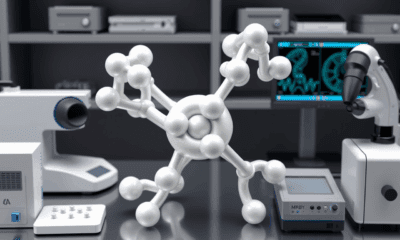While we try to keep things accurate, this content is part of an ongoing experiment and may not always be reliable.
Please double-check important details — we’re not responsible for how the information is used.
Acoustics
A Silent Hazard: How Electric Vehicle Safety Signals Can Be Misinterpreted by Humans
As electric vehicles grow more popular, their warning sounds may not be doing enough to protect pedestrians. A Swedish study shows that these signals are hard to locate, especially when multiple vehicles are involved, leaving people unable to tell where danger is coming from or how many cars are nearby.

Acoustics
The Hidden Order of Glass Revealed: Unlocking the Secrets of Vibrational Fluctuations in the Terahertz Region
Although glasses exhibit disordered atomic structures, X-ray and neutron scattering reveal a subtle periodicity. Researchers have demonstrated that this hidden periodicity — referred to as ‘invisible order’ — plays a critical role in determining vibrational fluctuations in the terahertz (THz) frequency range, which significantly influence the physical properties of glass.
Acoustics
Cracking the Code on Next-Generation Engine Noise: A Breakthrough Study Reveals Why Electric Aircraft Engines Sound Annoying and How to Fix It
A breakthrough study has revealed why emerging electric aircraft engine technology sounds so annoying — and how to fix it.
Acoustics
Harnessing Microbubbles for Advanced Fluid Control
A watched pot never boils, goes the old saying, but many of us have at least kept an eye on the pot, waiting for the bubbling to start. It’s satisfying to finally see the rolling boil, behind which complex physical mechanisms are at play. When this happens, the bubbles that form continuously change in shape and size. These dynamic movements influence the surrounding fluid flow, thereby affecting the efficiency of heat transfer from the heat source to the water. Manipulating small amounts of liquid at high speeds and frequencies is essential for processing large numbers of samples in medical and chemical fields, such as in cell sorting. Microbubble vibrations can create flows and sound waves, aiding in liquid manipulation. However, the collective behavior and interactions of multiple bubbles is poorly understood, so their applications have been limited.
-

 Detectors9 months ago
Detectors9 months agoA New Horizon for Vision: How Gold Nanoparticles May Restore People’s Sight
-

 Earth & Climate10 months ago
Earth & Climate10 months agoRetiring Abroad Can Be Lonely Business
-

 Cancer10 months ago
Cancer10 months agoRevolutionizing Quantum Communication: Direct Connections Between Multiple Processors
-

 Albert Einstein10 months ago
Albert Einstein10 months agoHarnessing Water Waves: A Breakthrough in Controlling Floating Objects
-

 Chemistry10 months ago
Chemistry10 months ago“Unveiling Hidden Patterns: A New Twist on Interference Phenomena”
-

 Earth & Climate10 months ago
Earth & Climate10 months agoHousehold Electricity Three Times More Expensive Than Upcoming ‘Eco-Friendly’ Aviation E-Fuels, Study Reveals
-

 Agriculture and Food10 months ago
Agriculture and Food10 months ago“A Sustainable Solution: Researchers Create Hybrid Cheese with 25% Pea Protein”
-

 Diseases and Conditions10 months ago
Diseases and Conditions10 months agoReducing Falls Among Elderly Women with Polypharmacy through Exercise Intervention





























